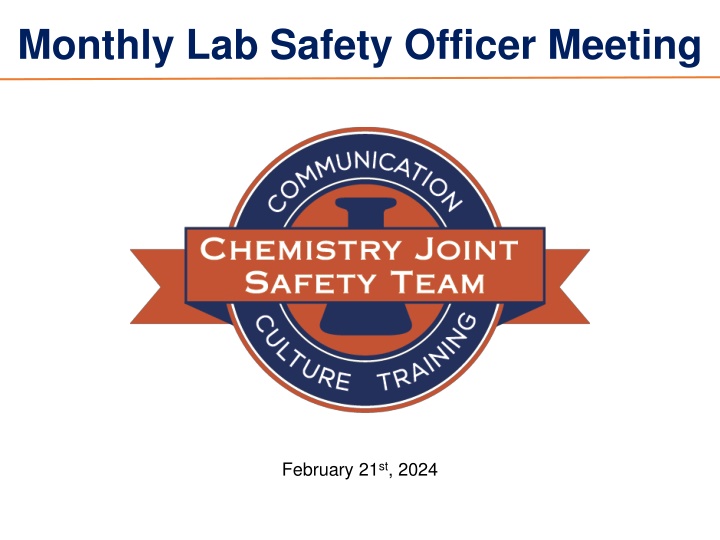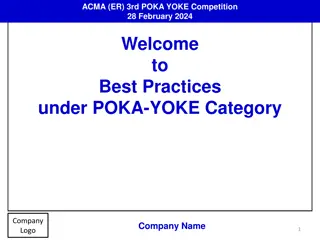
Lab Safety Officer Meeting: Risk Assessment and Chemical Hazards Overview
Explore the importance of risk assessment in lab safety, learn to recognize chemical hazards, and engage in discussions on facilities updates in this informative meeting. Stay informed to enhance safety protocols.
Download Presentation

Please find below an Image/Link to download the presentation.
The content on the website is provided AS IS for your information and personal use only. It may not be sold, licensed, or shared on other websites without obtaining consent from the author. If you encounter any issues during the download, it is possible that the publisher has removed the file from their server.
You are allowed to download the files provided on this website for personal or commercial use, subject to the condition that they are used lawfully. All files are the property of their respective owners.
The content on the website is provided AS IS for your information and personal use only. It may not be sold, licensed, or shared on other websites without obtaining consent from the author.
E N D
Presentation Transcript
Monthly Lab Safety Officer Meeting February 21st, 2024
Agenda 1. Announcements a) Change of LSO Form https://forms.gle/BsQQuzsK5F7c3kqq6 b) Reporting Incidents to DRS Phone: 217-333-2755 Email: drs@illinois.edu Submit an Event Report: https://forms.illinois.edu/sec/1674176205?referrer=https://shibboleth.illinois.edu/ c) Anonymous Near Misses and Incidents Form https://forms.gle/88wVJ8gHXFoMqBtw5 2. Open Discussion Facilities Issues/Updates a) 3. Recent Near Miss/Incident Reports None submitted this month a) 4. Safety Minute RAMP Risk Assessment a) 5. New Slack Channel for LSOs https://join.slack.com/t/uiucchemistrylsos/shared_invite/zt-2d4ejfwcl- GK_WKPUM~HxEr05PS~TZvQ a) 2
Open Discussion Any Facilities Issues or Updates? Safety concerns or comments? Suggestions for future meeting topics? 3
What is risk assessment? Risk assessment - process of evaluating the potential hazards and risks that may be associated with an activity Hazard - inherent property of a material or situation that has a potential for harm and cannot be altered Can be chemical, biological, radiological, physical Examples: Hexane is hazardous because it is flammable. Risk - the probability that a hazard will result in adverse consequence, and the severity of that consequence Can be applied to property, materials, and people Example: 10 mL vs. 100 mL hydrochloric acid (same hazard but different risk associated when working with each volume) Hazard is an inherent property that can t be changed, but risk can be minimized! Slide adapted from Brain Meschewski (DRS) and DRS website page on SOPs
How to perform a risk assessment? RAMP Recognize the hazards (hazard identification) Identify materials, instruments, experimental conditions and techniques, and anything that can create a hazard Slide adapted from Brain Meschewski (DRS) and DRS website page on SOPs
Recognizing chemical hazards Chemical hazards fall into three main groups: physical, health, and environmental hazards Initial inspection of chemical containers shows major hazards pictograms Oxidizer, increases likelihood of/increases fire Severe explosion and fire hazard Pressurized gas https://www.pure-chemical.com/blog/hazard-symbols/
Recognizing chemical hazards More comprehensive and detailed hazard information found in Safety Data Sheets (SDS) 1 = most severe hazard 4 = least severe hazard PubChem https://www.sigmaaldrich.com/US/en/sds/sigald/179124 https://pubchem.ncbi.nlm.nih.gov/compound/180#section=Safe-Storage https://www.osha.gov/sites/default/files/publications/OSHA3678.pdf
Recognizing physical and operational hazards Physical hazard inherent property of an object to cause physical harm Examples: Sharp broken glass, hot heating element, laser damage to eyes Operational hazards potential for harm caused by equipment failures, human errors, or deviations from planned parameters Example: Temperature of furnace overshoots setpoint Read hazard descriptions in instrument/equipment manuals and consult researchers who are experienced with the specific equipment or technique.
How to perform a risk assessment? RAMP Recognize the hazards (hazard identification) Identify materials, instruments, experimental conditions and techniques, and anything that can create a hazard Assess the risks of the hazards Determine the risks posed by hazards during an experiment Before performing an experiment, think about the risks you may be exposed to What-If analysis Risk (R) = Probability of occurrence (P) x Severity of Consequence (S) Slide adapted from Brain Meschewski (DRS) and DRS website page on SOPs
Risk assessment approach P S No effect Minor Light Heavy Catastrophic Unlikely Remote Occasional Repeated Frequent For each hazard determine where it would fall on the graph Implement controls to move your procedure into green away from yellow and red Slide adapted from Brain Meschewski (DRS) and DRS website page on SOPs
How to perform a risk assessment? RAMP Recognize the hazards (hazard identification) Identify materials, instruments, experimental conditions and techniques, and anything that can create a hazard Assess the risks of the hazards Determine the risks posed by hazards during an experiment Before performing an experiment, think about the risks you may be exposed to What-If analysis Risk (R) = Probability of occurrence (P) x Severity of Consequence (S) Minimize the risk of the hazards Hierarchy of controls Slide adapted from Brain Meschewski (DRS) and DRS website page on SOPs
Hierarchy of Controls Start at the top and work your way down Not all will be effective for each experiment or situation Slide adapted from Brain Meschewski (DRS) and DRS website page on SOPs
How to perform a risk assessment? RAMP Recognize the hazards (hazard identification) Identify materials, instruments, experimental conditions and techniques, and anything that can create a hazard Assess the risks of the hazards Determine the risks posed by hazards during an experiment Before performing an experiment, think about the risks you may be exposed to What-If analysis Minimize the risk of the hazards Hierarchy of controls Prepare for emergencies Know the location and proper use of emergency response equipment Know who to contact during an emergency and when to leave the situation to professional responders Slide adapted from Brain Meschewski (DRS) and DRS website page on SOPs
Preparing for emergencies What is the worst that can happen? Prepare plans to safely handle possible scenarios: Fire in lab What to know: Location of fire extinguishers and how to use them, who to alert, when to evacuate Chemical exposure What to know: Signs and symptoms of exposure to chemical being used, what to do in case of exposure, who to alert Always practice situational awareness! Envision what the safe laboratory scene would look like and imagine possible warning signs of danger that may appear. Slide adapted from Brain Meschewski (DRS) and DRS website page on SOPs
Lets practice applying RAMP Acid digestion protocol Slide adapted from Risk Management in the Research Lab: RAMP Workshop by the ACS Division of Chemical Health and Safety
New Slack Channel for LSOs Working with a new hazard and seeking safety-related advice from other experienced LSOs? Have safety-related advice to share with other LSOs? Join the LSOs Slack Channel! https://join.slack.com/t/uiucchemistrylsos/shared_invite/zt-2d4ejfwcl- GK_WKPUM~HxEr05PS~TZvQ Disclaimer: This form of communication does not take the place of an official DRS or SCS Facilities consultation. It is simply a method of sharing resources and perspectives and keeping the LSO community connected. 18
Thank you for coming! Please forward LSO meeting recap email/slides to your group! We can stay for a few minutes if there are further questions. 19






















